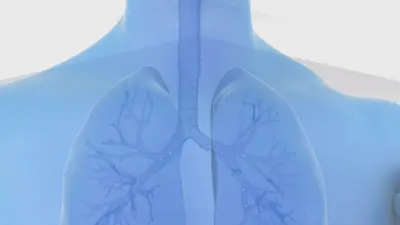FeNO value for diagnosis and control

Standardized measurement for determining bronchial NO
To obtain a sample of NO produced in the bronchial tubes, the exhaled breath has to be fractionated. The measurement of fractional exhaled NO (FeNO) has been standardized for clinical measurement.2,3 The NO fraction from the bronchoalveolar chamber is measured during slow, controlled exhalation through a mouthpiece. The soft palate (velum) must be closed to prevent contamination with NO from the upper respiratory tract. The closure of the velum is achieved by exhaling against a resistance of between 5 and 20 cm H₂O. A constant flow of 50 ml/s must also be maintained during breathing maneuvers.

Standardized measurement for determining bronchial NO

FeNO measurement has become a recognized standard diagnostic procedure and is used daily in medical practices and clinics all over the world. It is quick and easy to perform and is non-invasive and stress-free for the patient.
- Exhalation against resistance (velum closure between 5 and 20 cm H₂O)
- Slow, controlled, and constant rate of exhalation (50 ml/s)
- Measurement after bypassing the respiratory volume of the lower respiratory tract (fractionation)
Importance of FeNO measurement for diagnostics and therapy
- Numerous studies verify the importance of FeNO measurement in delivering diagnosis confirmation and a prognosis of response to treatment with inhaled corticosteroids (ICS).4,5,6
- Regular FeNO measurement simplifies the monitoring of airway inflammation and may provide information about patients’ adherence to ICS treatment.7
- FeNO-based monitoring supports therapy management and can help to prevent exacerbation.8
- Increased FeNO values indicate a worsening of the course of the disease even before a conspicuous pulmonary function test result and therefore allow early therapeutic countermeasures to be taken.9
Interpretation of FeNO results
The unit of measurement for NO concentration in air is ppb (parts per billion). In healthy adults, the FeNO value is usually below 25 ppb. A FeNO value above 50 ppb indicates an acute allergic inflammatory event in the lungs.

What do international experts say about FeNO measurement in asthma diagnostics?
Germany
In the revised version of the German Asthma Guideline,6 the determination of nitric oxide in breath exhalate (FeNO) is mentioned as part of the initial asthma diagnosis and repeated measurements are recommended.
US
The American Thoracic Society (ATS) guidelines7 also recommend FeNO measurement for diagnosis, treatment management, and monitoring of asthma patients.
UK
This is supported by a recent English study review8 from 2019/20. This states:
FeNO has also been shown to be a predictive factor for asthma exacerbations, with higher levels associated with a greater number of exacerbations. In addition, higher FeNO levels have been shown to be associated with deteriorating lung function. FeNO testing is a cost-effective procedure and has been shown to improve patient management when combined with standard assessment methods.
The Clinical Guideline on Asthma from the National Institute for Health and Care Excellence (NICE)5 in the United Kingdom also recommends including FeNO measurement in the diagnostic algorithm to improve diagnostic quality and assesses FeNO as a significant parameter for the long-term management of asthma: “Consider using FeNO testing as an option to assist in the asthma management of people who continue to have asthma symptoms despite inhaled corticosteroids.”
1 Baur et al. Dt. Ärzteblatt, 2007
2 ATS/ERS Am J Respir Crit Care Med 2005;171:912-30
3 Horváth et al. Eur Respir J 2017;49:1600965
4 Dweik et al. Am J Respir Crit Care Med 2011;184:602-15
5 Karrasch et al. Thorax 2017;72:109-16
6 Taylor et al. Thorax 2006;61:817-27
7 Petsky et al. Cochrane Database of Systematic Reviews 2016;9: CD011440
8 Essat et al. Eur Respir J 2016;47:751-68
9 Bodini et al. Chest 2017;132:1520-25
10 NICE: Guideline Asthma - diagnosis and monitoring (November 2017, www.nice.org.uk)
11 NVL Asthma, 3. Auflage, Version 1 (September 2018, https://www.leitlinien.de/mdb/downloads/nvl/asthma/asthma-3aufl-vers1-lang.pdf)
12 Schneider et al. Respir Med. 2014; 108(1):34-40
This website contains general product information about the Vivatmo system from Bosch. Not all products and their functions mentioned here are approved in every regional market. For a detailed description of the products and features as well as information on intended and safe use, please refer to your locally authorized Bosch distribution partner and the instructions for use that are valid for your country.


